Project Evaluation of the Epidemic Prevention Campaign for Infectious and Emerging Diseases by Lopburi Provincial Administrative Organization, Fiscal Year 2024
DOI:
https://doi.org/10.57260/stc.2024.960Keywords:
Project evaluation, Prevention campaign, Infectious diseases, Emerging diseasesAbstract
This evaluative research study aimed to evaluate the campaign project to prevent the spread of infectious and emerging diseases of the Lopburi Provincial Administrative Organization in fiscal year 2024 according to the project evaluation model of CIPP Model. A purposive sample of 200 participants in the campaign to prevent the spread of infectious and emerging diseases. Data collection was conducted between January and May 2024. The instrument used in this study was a questionnaire developed by the researcher based on a literature review. Data were analyzed using descriptive statistics, paired t-test statistics, and content analysis. The results of the study revealed that: The majority of the sample was female , aged between 50-59 years and had completed primary school. The sample had the highest level of overall project opinions, the highest level of contextual opinions, input factors, process opinions and output opinions. The sample group had the highest level of knowledge about the prevention of infectious and emerging diseases after joining the project (p-value <.001). The overall satisfaction level of the project was at the highest level. Hence, in disease prevention and management, there should be ongoing training to equip public health volunteers with the necessary knowledge. This can be achieved by extending the project duration and offering a diverse range of exhibitions. Additionally, providing support materials in various formats will enable public health volunteers to effectively apply their acquired knowledge in preventing and controlling infectious diseases, as well as monitoring emerging diseases within the community.
Downloads
References
กรมควบคุมโรค. (2567). กฎหมายที่เกี่ยวข้อง : พระราชบัญญัติโรคติดต่อ พ.ศ. 2558. Retrieve from https://ddc.moph.go.th/law.php?law=1
กองแผนงาน กรมควบคุมโรค. (2560). แผนพัฒนาด้านการป้องกันควบคุมโรคและภัยสุขภาพของประเทศ ระยะ 20 ปี (พ.ศ. 2560 - 2579). พิมพ์ครั้งที่ 1. กรุงเทพฯ: สำนักพิมพ์อักษรกราฟฟิคแอนด์ดีไซน์.
ก่อศักดิ์ จันทรวิจิตร. (2566). การประเมินผลการดําเนินงานโครงการเฝ้าระวัง ป้องกัน ควบคุม โรคเบาหวาน และความดันโลหิตสูงด้วย“ปิงปองจราจรชีวิต 7 สี” จังหวัดสิงห์บุรี โดยใช้ CIPP Model. วารสาร สาธารณสุขและวิทยาศาสตร์สุขภาพ, 6(2), 80-93. สืบค้นจาก https://he02.tci-thaijo.org/index.php/tjph/article/view/264519/180835
เกศิณี วงศ์สุบิน, ขวัญเมือง แก้วดำเกิง, ธราดล เก่งการพานิช และ มณฑา เก่งการพานิช. (2559). ผลของ โปรแกรมการเสริมสร้างพลังอำนาจของอาสาสมัครสาธารณสุขประจำหมู่บ้านในการป้องกันและควบคุมโรคไข้เลือดออกตำบลโป่งน้ำร้อน อำเภอโป่งนำ้ร้อน จังหวัดจันทบุรี. วารสารศูนย์การศึกษาแพทยศาสตร์คลินิก โรงพยาบาลพระปกเกล้า, 33(3), 196-209. สืบค้นจาก https://he02.tci-thaijo.org/index.php/ppkjournal/article/view/68419/56374
ธีรศักดิ์ คันศร, กุลชญา ลอยหา, จำลอง วงศ์ประเสริฐ และ เด่นดวงดี ศรีสุระ. (2562). ผลของโปรแกรมการเสริมสร้างพลังอำนาจอาสาสมัครสาธารณสุขประจำหมู่บ้านด้านการป้องกันและควบคุมโรคไข้เลือดออกในเขตเมืองอุบลราชธานี. วารสารสำนักงานป้องกันควบคุมโรคที่ 7 ขอนแก่น, 26(3), 25-35. สืบค้นจาก https://he01.tci-thaijo.org/index.php/jdpc7kk/article/view/232218/158554
ธีรศักดิ์ เลื่อยไธสง. (2549). การบริหารวิชาการของสถานศึกษาขั้นพื้นฐานที่เป็นนิติบุคคลเรื่องที่ 7: การนิเทศ การศึกษา (Educational Supervision) สาสน์นิเทศการศึกษา (Educational Supervision Message: ESM). กรุงเทพฯ.
พงศกร ตันติวรางกูร. (2566). การพัฒนารูปแบบการปฏิบัติงานของอาสาสมัครสาธารณสุขร่วมกับสำนักงาน สาธารณสุขอำเภอลี้ในพื้นที่ถ่ายโอนให้องค์การบริหารส่วนจังหวัดลำพูน. วารสารวิจัยการพยาบาล และการสาธารณสุข, 3(3), 62-76. สืบค้นจาก https://he02.tci-thaijo.org/index.php/jnphr/article/view/263889/181574
รุ่งนภา จันทรา, ลัดดา เรืองด้วง และ ชุลีพร หีตอักษร. (2565). ผลของโปรแกรมส่งเสริมความรู้ในการช่วยฟื้นคืนชีพขั้นพื้นฐานกรณีเด็กจมน้ำในอาสาสมัครสาธารณสุขประจ้าหมู่บ้านในโรงพยาบาลส่งเสริมสุขภาพตำบลคลองฉนาก จังหวัดสุราษฎร์ธานี. วารสารเครือข่ายวิทยาลัยพยาบาลและการสาธารณสุขภาคใต้, 9(3), 38-48. สืบค้นจาก https://he01.tci-thaijo.org/index.php/scnet/article/view/244688/174668
ศศิณัฎฐ์ สรรคบุรานุรักษ์. (2559). การประเมินโครงการศึกษาดูงานภาคฤดูร้อนด้านภาษา ศิลปะและ วัฒนธรรมจีนของคณะศึกษาศาสตร์ มหาวิทยาลัยศิลปากร. วารสารมหาวิทยาลัยพายัพ, 26(2), 55- 73. สืบค้นจาก https://so05.tci-thaijo.org/index.php/pyu/article/view/128436/96540
สมัย พูลทอง, เจริญชัย คำแฝง, ชนะ หอมจันทร์, จีระนันท์ คำแฝง และ ทวีศักดิ์ จันทร์หอม. (2556). การ ประเมินผลโครงการอำเภอควบคุมโรคเข้มแข็งแบบยั่งยืน อำเภอเขื่องใน จังหวัดอุบลราชธานี. วารสารควบคุมโรค, 39(3), 266-271. สืบค้นจาก https://he01.tci-thaijo.org/index.php/DCJ/article/view/155083/112757
สำนักงานคณะกรรมการการกระจายอำนาจให้แก่องค์กรปกครองส่วนท้องถิ่น. (2567). กฎหมายเกี่ยวกับการ ปกครองท้องถิ่น. สืบค้นจาก https://odloc.go.th
หทัยชนก บัวเจริญ, ดารินทร์ โพธิ์ตั้งธรรม และ วิกานต์ดา โหม่งมาตย์. (2564). การพัฒนารูปแบบการป้องกันโรคไข้เลือดออกของอาสาสมัครสาธารณสุขประจำหมู่บ้านโดยการส่งเสริมการทำงานแบบมีส่วนร่วม. วารสารควบคุมโรค, 41(4), 982-994. สืบค้นจาก https://he01.tci-taijo.org/index.php/DCJ/article/view/155083/112757
องค์การบริหารส่วนจังหวัดลพบุรี. (2566). รายงานความคิดเห็นและความต้องการของประชาชนพื้นที่จังหวัด ลพบุรี. ลพบุรี: องค์การบริหารส่วนจังหวัดลพบุรี.
องค์การบริหารส่วนจังหวัดลพบุรี. (2567). รายงานโครงการรณรงค์ป้องกันการแพร่ระบาดของโรคติดต่อและ โรคอุบัติใหม่ ปีงบประมาณ 2567. ลพบุรี: องค์การบริหารส่วนจังหวัดลพบุรี.
Stufflebeam, D. L. (1968). Evaluation as Enlightenment for Decision – Making. Ohio: Ohio State University Evaluation Center.
World Health Organization. (2024). Emerging diseases. Retrieve from https://www.emro.who.int/health-topics/emerging-diseases/index.html
Downloads
Published
How to Cite
Issue
Section
License
Copyright (c) 2024 Science and Technology to Community

This work is licensed under a Creative Commons Attribution-NonCommercial-NoDerivatives 4.0 International License.
1. Articles, information, content, images, etc. that are published in "Science and Technology for Community Journal" is the copyright of science and Technology for Community Journal. Chiang Mai Rajabhat University. If any person or organization wants to distribute all or any part of it or do any action Must have written permission from the science and Technology for Community Journal, Chiang Mai Rajabhat University.
2. Content of articles appearing in the journal is the responsibility of the author of the article. The journal editor is not required to agree or take any responsibility.














